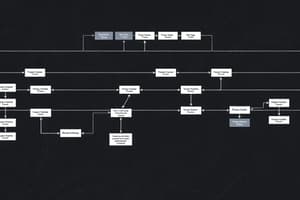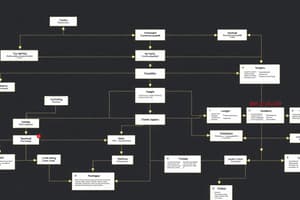Podcast
Questions and Answers
What is the primary purpose of process mapping?
What is the primary purpose of process mapping?
- To develop training programs.
- To enhance understanding and identify inefficiencies. (correct)
- To create a project timeline.
- To monitor team productivity.
Which type of process map specifically focuses on responsibilities across different departments?
Which type of process map specifically focuses on responsibilities across different departments?
- Value Stream Map
- Flowchart
- Swimlane Diagram (correct)
- Stakeholder Map
Which of the following is NOT a key element of process mapping?
Which of the following is NOT a key element of process mapping?
- Inputs and Outputs
- Budget Allocation (correct)
- Stakeholders
- Decision Points
What is the first step in creating a process map?
What is the first step in creating a process map?
Which type of process map emphasizes both value-added and non-value-added activities?
Which type of process map emphasizes both value-added and non-value-added activities?
What is one benefit of using process mapping?
What is one benefit of using process mapping?
What should be done after drafting a process map?
What should be done after drafting a process map?
What element helps indicate where choices are made that affect the flow of a process?
What element helps indicate where choices are made that affect the flow of a process?
Flashcards are hidden until you start studying
Study Notes
Process Mapping
-
Definition:
- Process mapping is a visual representation of the steps involved in a process, detailing inputs, outputs, and the sequence of activities.
-
Purpose:
- To enhance understanding of processes.
- To identify inefficiencies and areas for improvement.
- To standardize processes across teams.
-
Types of Process Maps:
- Flowcharts: Basic diagrams showing the flow of a process using standard symbols.
- Swimlane Diagrams: Illustrate processes across different departments or roles, clarifying responsibilities.
- Value Stream Maps: Focus on value-added and non-value-added activities, commonly used in Lean methodologies.
-
Key Elements:
- Start and End Points: Clearly define where the process begins and ends.
- Activities/Tasks: Detail all steps or tasks in the process.
- Decision Points: Indicate where choices are made that affect the flow.
- Inputs and Outputs: Specify what is required to perform the process and what results from it.
- Stakeholders: Identify individuals or teams involved at various stages.
-
Steps for Creating a Process Map:
- Identify the Process: Define the scope and objectives of the mapping effort.
- Gather Information: Collect data from stakeholders on the current process.
- Define Boundaries: Establish what is included in the process and what is out of scope.
- List Steps: Document each step in the current process sequentially.
- Draft the Map: Create a visual representation using appropriate symbols and notations.
- Validate with Stakeholders: Review the map with involved parties to ensure accuracy.
- Refine and Finalize: Make necessary adjustments based on feedback and finalize the map.
-
Benefits:
- Improved communication among team members.
- Enhanced clarity in processes leading to better training materials.
- Ability to analyze and improve process efficiency.
-
Common Tools:
- Microsoft Visio
- Lucidchart
- Miro
- Draw.io
-
Best Practices:
- Keep it simple and focused on key processes.
- Use consistent symbols and terminology.
- Regularly update process maps to reflect changes.
Process Mapping Overview
- Process mapping visually represents a process, outlining steps, inputs, outputs, and activity sequences.
Purpose of Process Mapping
- Enhances understanding of processes, making them clearer to all stakeholders.
- Identifies inefficiencies and potential areas for improvement.
- Aims to standardize processes across teams, promoting consistency.
Types of Process Maps
- Flowcharts: Basic diagrams illustrating the sequence of a process with standard symbols.
- Swimlane Diagrams: Show process responsibilities across various departments or roles for clarity.
- Value Stream Maps: Focus on distinguishing value-added from non-value-added activities, often utilized in Lean methodologies.
Key Elements of a Process Map
- Start and End Points: Clearly mark where the process originates and concludes.
- Activities/Tasks: Document each step involved in the process in detail.
- Decision Points: Highlight areas where choices impact the process flow.
- Inputs and Outputs: Specify necessary resources for the process and resulting outcomes.
- Stakeholders: Identify all individuals or teams engaged at different stages of the process.
Steps for Creating a Process Map
- Identify the Process: Define the process's scope and objectives clearly.
- Gather Information: Collect current process data from stakeholders for accurate representation.
- Define Boundaries: Establish inclusions and exclusions for the mapping effort.
- List Steps: Document each sequential task in the current process.
- Draft the Map: Visual representation created using suitable symbols and notations.
- Validate with Stakeholders: Review the draft with involved parties to ensure correctness.
- Refine and Finalize: Adjust the draft based on feedback and complete the final version.
Benefits of Process Mapping
- Improves communication among team members, fostering collaboration.
- Enhances clarity in processes, leading to better training and onboarding materials.
- Enables analysis and enhancement of process efficiency.
Common Tools for Process Mapping
- Microsoft Visio
- Lucidchart
- Miro
- Draw.io
Best Practices for Effective Process Mapping
- Maintain simplicity and focus solely on key processes to avoid confusion.
- Use consistent symbols and terminology for clarity and understanding.
- Regularly update process maps to reflect any changes and ensure relevance.
Studying That Suits You
Use AI to generate personalized quizzes and flashcards to suit your learning preferences.




